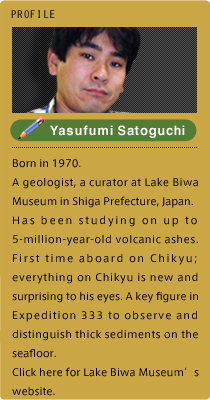

“Starting Afresh; Beginning of 2011”2011.1.5
Happy new year! This is Satoguchi aboard Chikyu again. Even though it is a new year, we are working as usual, in our usual shift hours. I went out to the deck with other night shift people to see the sunrise. But unfortunately, it was cloudy, so we could not see the first sunrise of the year 2011, shame!
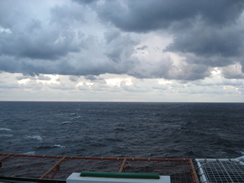
View of the sky from Chikyu at around the sunrise time.
Let’s continue with the interview. Moving on to the scientists from geochemistry field, and I have to admit that it is not really my cup of tea… Well, if you could read this report with some consideration for this, it would be highly appreciated.
I first went to Marion, who was working on her analysis nearby, trying to ask for some contribution to my interview for “Report from Chikyu”. She is working on her chemical entity of sediments by using an analyser called XRF.
Her target is to analyse the changes in chemical entities, to see how they change as the depth gets deeper. These changes, as she explains, are related to alteration conditions of the sediments. However, she says it takes so long to make samples for this analysis. Yes, the modification and so on do take time, I can imagine that.
Next, let’s ask Dr. Saito, whom I had known since before getting aboard Chikyu. His speciality used to be sedimentology, specialised in flood flow, but in this expedition, he is aboard as an inorganic geochemist. What changed him? Anyways, he says he is now studying the water within the underground sediments, and analysing their chemical behaviours/properties. So, what can he discover by studying them?
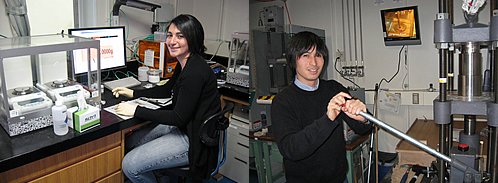
Marion (left) and Yu (Dr. Saito) from inorganic geochemistry group. Preparing samples for analysis. Yu is squeezing out the water contained in mud.
Yu says, “The sediments in the deep sea are literally building up in the ocean, so the particles are affected by sea water. Analysing how the sea water properties change can help us understand underground water movements. I suppose that such water movements are playing an important role in this particular area, where plate subduction and earthquake occur.
I see... So, what has excited him so far in this expedition? “I go to see the cores every time when they come up. The mud from below the seafloor has been under high pressure, so we need to make small holes for safety check first. When they do this, the mud comes out like pasta. It looks funny and I like it.”
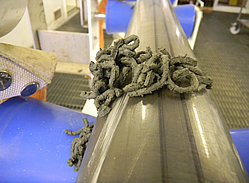
Pasta-like mud? Sometimes they burst, so the check has to be done carefully.
The last person to interview. Let’s ask this gentleman from organic geochemistry field. “Could I interview you, for a few minutes?” “Sure.” He replied with a shy smile. His real interest is the microorganisms that live in underground, but in this expedition, his work is based on organic compounds such as methane.
I simplify what he told me about his research here. In the ocean, clay and sand accumulate and form sediments on the seafloor. These sediments contain organic matters, which were produced by algae and bacteria on the ocean surface with plenty of sunlight. The measurements of these matters in the sediments are necessary for simulating the environments, such as ocean currents, sea water temperature, amount of nutrient etc., of millions to hundreds of thousands of years ago. Actually, when I was a little puzzled as I interviewed him, he said he would write me a simplified explanation. So, what I am writing here is based on his writing. It was so nice of him to help me with this report!
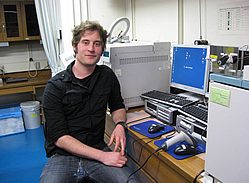
Thorsten from organic geochemistry group. His nickname is Thoddy. He looks like a fashion magazine model but talks about his research with his passion in his eyes. He must have lots of fans out there…! Photo taken in analytical processing lab.
So, thank you all the night-shifters who kindly contributed in my interview project. Why only night shifters? That is because I am a night shifter!
And for our new year celebration on the sea, we had “Kakizome” (a special calligraphy for new year) event.
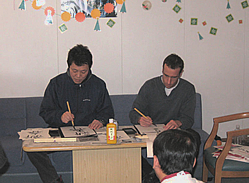
The co-chief scientists deeply absorbed in their Kakizome calligraphy. They wrote “New Year” and “Chikyu” in Japanese.
Yasufumi Satoguchi














